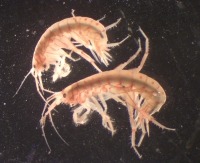
(Photo: Huntsman Marine Science Centre)
Bigelow's Amphipod
Casco bigelowi
Amphipod 10 to 20 millimetres long. It has distinctive red and white stripes. The body is dorsolaterally flattened (thinnest when viewed from above). The front angle of the head and first side plate are strongly produced into pointed flanges.
Authority
Blake, 1929
Classification Details
Phylum: Arthropoda (arthropods); Subphylum: Crustacea (crustaceans); Order: Amphipoda (amphipods).
Habitat
This burrow-dwelling amphipod is found on the Atlantic coast of North America. It lives in muddy sediments in low intertidal to subtidal waters, in depths less than 150 metres. Not very abundant: densities do not usually exceed 100 individuals per metre². Species considered rare throughout its range.
Diet
A deposit feeder. It excavates, processes, and immediately redeposits subsurface sediments within its burrow system.
Reproduction
Females expand their homes to accommodate growing families. As juveniles increase in size, females will increase burrow systems to accommodate their growing young.
Fun Facts
This species was described just over the border in Casco Bay, Maine. It was named after Dr. Robert P. Bigelow of the Massachusetts Institute of Technology.
References
Procter W, Johnson CW and Blake CH (1927) Biological survey of the Mount Desert Region. Philadelphia: The Wistar Institute of Anatomy and Biology. Thiel M (1998) Reproductive biology of a deposit–feeding amphipod, Casco bigelowi, with extended parental care. Marine Biology 132, 107–116. Thiel M and Watling L (2015) The Natural History of the Crustacea: Vol.2: Lifestyles and feeding biology. New York: Oxford University Press. Van Guelpen L, Pohle G, Vanden Berghe E and Costello MJ (2005) Marine Species Registers for the North Atlantic Ocean. World Wide Web electronic publication. http://www.vliz.be/vmdcdata/narms/

